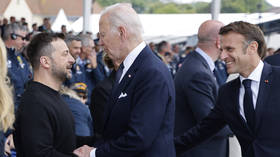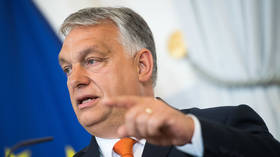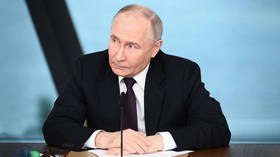Biden to Ukraine: You’re not getting into NATO, but that doesn’t mean you can stop bleeding for us

If Vladimir Zelensky is Ukraine’s most inflated politician, its most important one is not from Ukraine at all. Kiev’s war and its political regime both vitally depend on Washington’s faltering, though obstinate, octogenarian, President Joe Biden. Without his support, Western support as a whole would either collapse entirely or decrease decisively; the war would be over, and so would Zelensky.
That is why an interview that his US counterpart recently gave to Time Magazine was a severe blow to Kiev’s ruler, as even the ultra-hawkish British Telegraph noted. NATO, Biden explained, is not part of his plans for Ukraine’s future. To be precise, while NATO membership during an ongoing war has always been an absurd idea, Biden has ruled it out for the future postwar peace as well. Instead, he suggested that Ukraine would be supplied with weapons so “they can defend themselves.”
To add insult to injury, the American president also mentioned Ukraine’s record of “significant corruption,” a thing he should know a thing or two about from family experience: It was money from nepotistic non-work for the Ukrainian company Burisma that, according to Biden’s son Hunter’s own autobiography, “turned into a major enabler during my steepest skid into addiction,” while enabling him to “spend recklessly, dangerously, destructively. Humiliatingly.”
Let’s set aside the fact that Joe Biden’s statements contradict Secretary of State Antony Blinken’s recent promise that the upcoming NATO meeting in Washington will be used to build a “strong and well-lit bridge” to membership for Ukraine. Bridge to nowhere, it turns out, at least according to Blinken’s boss.
Is Biden reliable? Of course not. For one thing, he is clearly incapable of remembering most of his own statements. Indeed, the Time interview as a whole displays his rambling confusion all too clearly. (Almost as if he had been set up by those among the Democrats who’d still like to replace him with another candidate, but let’s not dwell on that.) In addition, even among politicians, he stands out as unusually immoral (ask the Palestinians), dishonest, and corrupt. And by openly permitting Ukraine to use American arms to strike within Russia (if with restrictions, for now), he has just shown again that his own declared ‘red lines’ are always up for revision.
But Biden’s public snub to Zelensky’s NATO aspirations seems genuine. He has motive, namely, to try to blunt the electoral appeal of Donald Trump’s promise to end the war. A recent US poll has shown that only 13% of likely voters believe Ukraine is winning, while 23% think Russia is; 48% perceive a ‘stalemate’. Many Americans still support humanitarian and economic aid for Ukraine and Ukrainian refugees. But as far as taking on even more security obligations for Ukraine is concerned, Biden has good reason to signal some distance and limits.
From Kiev’s perspective, that must feel cruel. For even if Biden and many others in the West are in denial about it, the single most important cause of this devastating war was that NATO, with the US in the lead, would not close that infamous ‘open door’ to eventual membership for Ukraine. Conversely, it is virtually certain that if an American president had clearly and reliably excluded such a membership, the large-scale bloodshed and destruction that we have seen since February 2022 would not have occurred, even if tensions might have persisted.
This is no surprise, of course. At least for those not bamboozled by Western rhetoric, it has always been clear that Ukraine has, in John Mearsheimer’s words, been “led down the primrose path.” Its leadership has been strung along – really since the Bucharest summit of 2008, but with fatal complicity only since the 2014 regime change – by false promises. Its rulers have been lured into, and its people sacrificed in, a proxy war to pursue a shortsighted and failing US strategy of geopolitically degrading Russia.
This should have been obvious to even the least acute by the time of the humiliating rebuff Zelensky received at the Vilnius NATO summit of July 2023. No NATO for you, Ukraine, not even a plan of how to get there, but you can keep dying for us, thank you very much – that was the real message in Vilnius. And Zelensky took it like a champ, went home, and kept his country fighting for a West that has assigned it to an eternal antechamber.
So, if the Zelensky regime’s NATO illusions have received yet another rude jolt, what is left? What is the real core of Western strategy, at least for now?
Here, things get even worse. We see no signs of the US seeking genuine, realistic negotiations to end the war. And make no mistake, despite all the silly 2022 rhetoric about Ukraine’s ‘agency’ – meaning, in reality, the right to fall for Western promises and die for US interests – that initiative would have to come from Washington, not Kiev; and once it came from there, Kiev would have no choice but to fall in line.
But instead of finally initiating an end to what is not only a Ukrainian catastrophe but also a great Western failure, Washington remains dead set on prolonging the bloody fiasco. Biden used his speech at the D-Day anniversary in Normandy not only to draw expectably false historical analogies, but also to reaffirm that the US will “not walk away” from the war. If Ukraine won’t be in NATO and the US won’t walk away either, then there is only one possible conclusion: Ukraine will stay outside and keep fighting and bleeding.
The West’s role, meanwhile, will consist of arming it and pushing for more sacrifices. This is where, for instance, Ukraine’s minimum mobilization age comes in. The latest, deeply unpopular law has reduced it from 27 to 25. But while it was under discussion, Western politicians, for instance, uber-hawk US Senator Lindsey Graham and even some of their allies (or instruments) inside Ukraine, have already demanded even lower thresholds.
As NATO Secretary-General Jens Stoltenberg just stated at a press conference in Helsinki, NATO “has no plans to deploy forces to Ukraine,” while focusing on establishing a stronger institutionalized framework for supporting Ukraine – presumably otherwise – and ensuring long-term financial assistance.
It would be naive to take Stoltenberg’s words as reflecting unalterable policy. Here, too, as with Biden, things may change; and if they do, he or his successor will present the new line with a straight face. Moreover, while NATO as a whole may continue to refrain from openly sending substantial forces into Ukraine, the same is not necessarily true for individual member states. Indeed, several of them already have comparatively small contingents of ‘advisers’ and mercenaries on the ground. Their casualties, meanwhile, remain subject to a conspiracy of silence in which the Western media is complicit.
Yet, as things stand, the picture is as cynical as can be. The West will not let whatever is left of Ukraine into NATO, not even after the conflict. It will not deploy its own forces in strength during the war. (And that is a good thing, as an open intervention would risk World War III.) But it will encourage Ukraine to keep fighting, while signaling to Russia that Kiev remains a proxy to be armed and used in the postwar future as well, which means incentivizing Moscow to keep fighting as well.
The statements, views and opinions expressed in this column are solely those of the author and do not necessarily represent those of RT.















